Though it may seem like one of those things that seems irrelevant when going into medicine, we can apply some of the basic concepts of circuits when modeling the body’s physiology, most specifically our circulatory system!
While this complete guide has some overlap with our “Electrostatics on the MCAT!” chapter overview, you’ll see that some of the concepts covered there have just been applied in a more practical sense.
After going through this chapter overview, you’ll have the basic ideas of circuits on the MCAT before diving into our more in depth articles. Let’s go!
Circuits on the MCAT: What You Need to Know
Topics on circuits will be tested on the Chem/Phys section of the MCAT and can appear both as passage based and fundamental discrete questions.
This is definitely one of the more high yield physics questions so maybe expect around 8-9 questions covering circuits on the MCAT!
Introductory physics accounts for 25% of the content covered in the Chemical and Physical Foundations of Biological Systems.
Important Sub-Topics: Circuits
As mentioned before, there is some overlap between this chapter overview and our “Electrostatics on the MCAT!” chapter overview! We suggest going over that one first so that you can get a better foundation before reviewing this chapter overview!
In addition, these physics topics might show up on the MCAT more as calculation based questions. Of course, this is not to discredit the theory behind the circuits, but it may give you a better idea of what to focus on when reviewing!
1. Current and Conductance
Circuits generally have 3 main components: 1) a conductive pathway usually in the form of wires, 2) a power source with voltage such as a battery, and 3) a load which uses electrical energy such as a light bulb.
The battery voltage source has a negative, anode terminal and a positive, cathode terminal. This drives how a circuit generates electrical energy as oxidation-reduction reactions take place where the anode loses electrons and the cathode gains the electrons lost by the anode.
Current simply refers to the flow of electrical charges within the circuit, just like the current of water that flows in a river! Current (I) is measured in the SI units amps, which is the amount of charge (Q) flowing per unit time (Δt).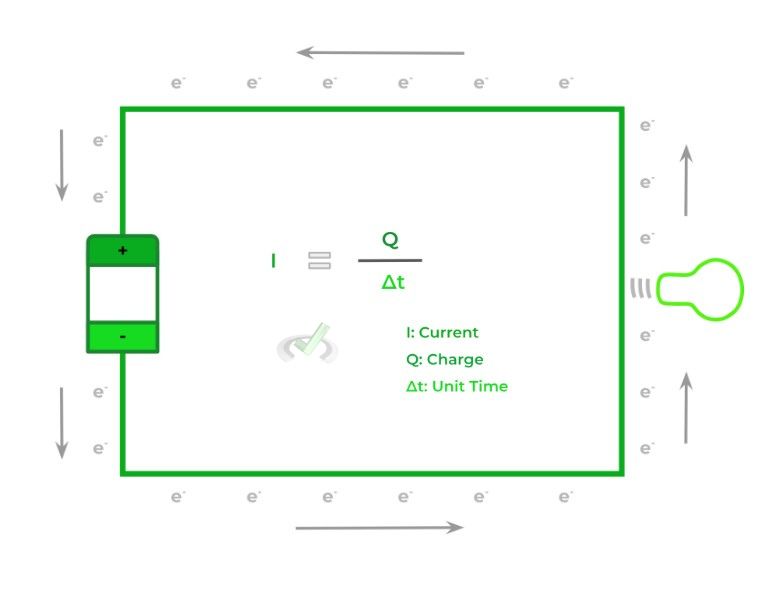
We should note an important convention in regard to current direction. The negatively charged electrons move toward the positive, cathode terminal as depicted above.
However, the proper convention of current direction is actually based on the direction a positive charge would go. Thus, the direction of the current (by proper convention) is opposite to the one shown above.
An important property that wires should have for a circuit to function is conductance, which basically measures how well a substance can support an electric current. Another way to view conductance is through an equation!
As shown below, the conductance of a material is actually the reciprocal of its resistance which will be discussed later.

Full Study Notes : Current and Conductivity
For more in-depth content review on current and conductivity, check out these detailed lesson notes created by top MCAT scorers.
2. Voltage and Ohm’s Law
Voltage is usually described as the electric potential difference, but let’s try to get a better understanding of what this means! A better way of understanding voltage is as the ratio of how much work (in joules) a charge can accomplish traveling within the circuit from one terminal to another.
For example, a battery that has a voltage of 1.5 V means that 1 joule of work can be done when 1 coulomb of charge moves from one end of the battery to another. What determines a battery’s voltage is the chemical oxidation-reduction reactions within the battery which yields the “pressure” which allows the electrons to move.
As mentioned above, another way to think about voltage is the “pressure” exerted by the battery cell on the electrons to move them from one terminal to the other terminal.
From this, an important law can be generated which is Ohm's law, which states that voltage is equal to the product of the current and resistance within a circuit. From here, we can make some important relationships between the variables. We’ll cover resistance shortly in the next section!
Most notably, we can see that the current is directly proportional to the voltage supplied. When we use our “pressure” analogy, we can say that an increase in voltage (“pressure”) increases the current!
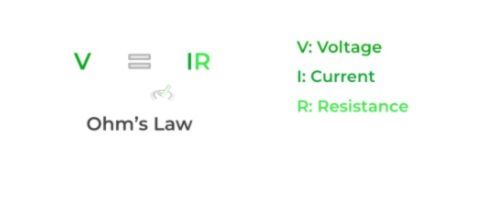
Full Study Notes : Voltage and Ohm’s Law
For more in-depth content review on voltage and how it applies to Ohm's law, check out these detailed lesson notes created by top MCAT scorers.
3. Resistance and Resistors
When applied to circuits, resistance is exactly what it sounds like! It refers to any opposition to the flow of charges within the circuit. Just as with other properties in circuit physics, we can model resistance (using ohms units -- 𝝮) as shown below!

Usually, this equation will be used in the context of the wires within the circuit as even the wires themselves can elicit some form of resistance! Note also the difference between resistivity and resistance: resistivity is an intrinsic property of the material while resistance accounts for all variables of resistivity, length, and cross-sectional area.
Likewise, resistors are simply circuit components that offer resistance to the circuit current. Because a current experiences resistance when it passes through a resistor, there is a voltage drop associated with the resistor due to Ohm’s law.
An interesting thing about resistors is how each of the resistors can be organized within a circuit, with there being 2 possible ways: those connected in series and those connected in parallel.
When resistors are connected in series, we can simply add the resistance of all the individual resistors together to get the total resistance. Because the electrons can only follow one path when resistors are in series, the current remains constant while the voltage drop associated with each resistor is dependent on the resistor’s resistance.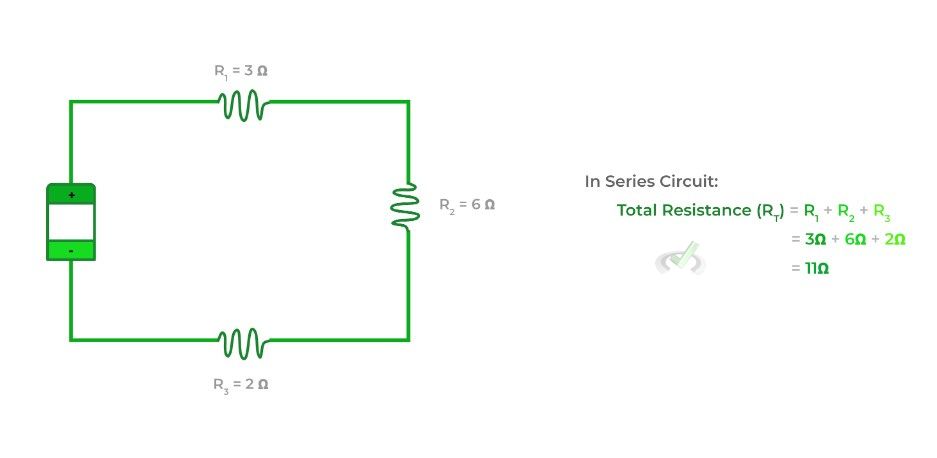
In contrast, when resistors are connected in parallel, we actually add the reciprocals of each resistor’s resistance together which is set equal to the reciprocal of the total resistance — this is a lot easier visualized as an equation as we’ll show!
In this case, adding resistors in parallel will actually decrease the total resistance because you increase the amounts of paths the current can take. This is the same thought process behind opening up more lanes on a highway to reduce traffic.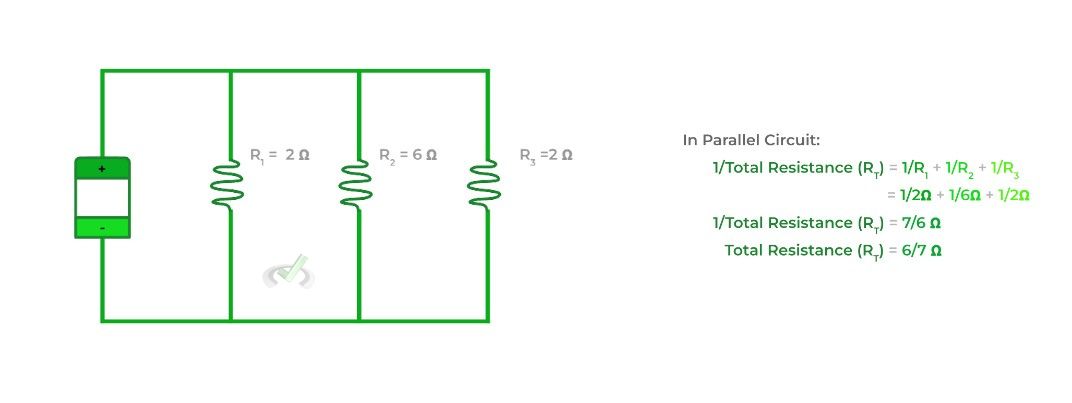
Full Study Notes : Resistance and Resistors
For more in-depth content review on resistance and resistors, check out these detailed lesson notes created by top MCAT scorers.
4. Capacitance and Capacitors
Sometimes, we may not want to use a voltage battery for powering a lightbulb; in some cases, we want to use charges released by the battery and store them for different uses. This is exactly what capacitors do!
Capacitors are generally composed of 2 metal plates: when a capacitor is connected to a circuit with a voltage source, one plate will accumulate a positive charge (+Q) and the other plate will accumulate a negative charge (-Q).
To find the capacitance (given in SI units farads, F), it’s simply the ratio between the b on plates and voltage, as given by the equation below:
Similar to resistors, multiple capacitors can also be arranged in circuits both in series and in parallel. However, the biggest distinction that should be made is that the additive properties of capacitors are the opposite of resistors.
When capacitors are placed in series, it is the same as adding resistors in parallel: we add the reciprocal of each capacitor's capacitance to the reciprocal of the total capacitance.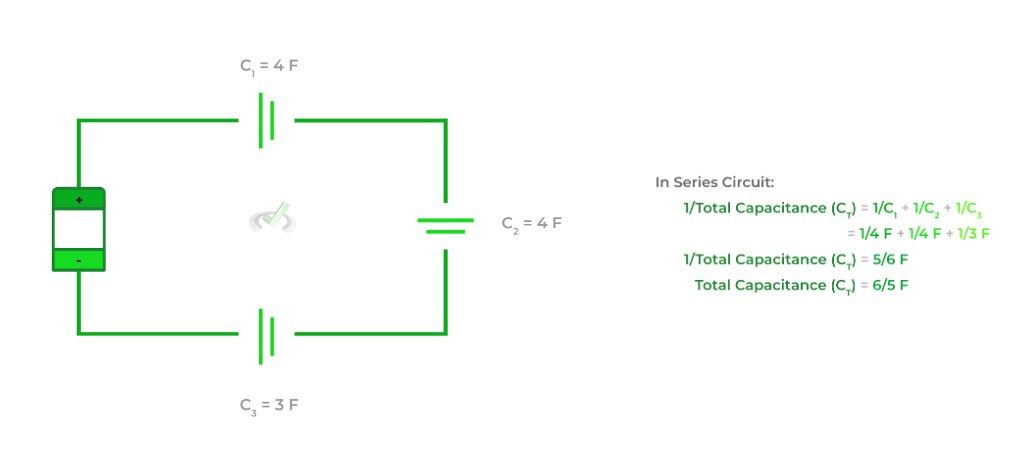
Conversely, when capacitors are placed in parallel, it’s the same as adding resistors in series: we simply add all the capacitor’s capacitances together to get the total capacitance. Notice again, how it’s the opposite of how you do it for resistors!
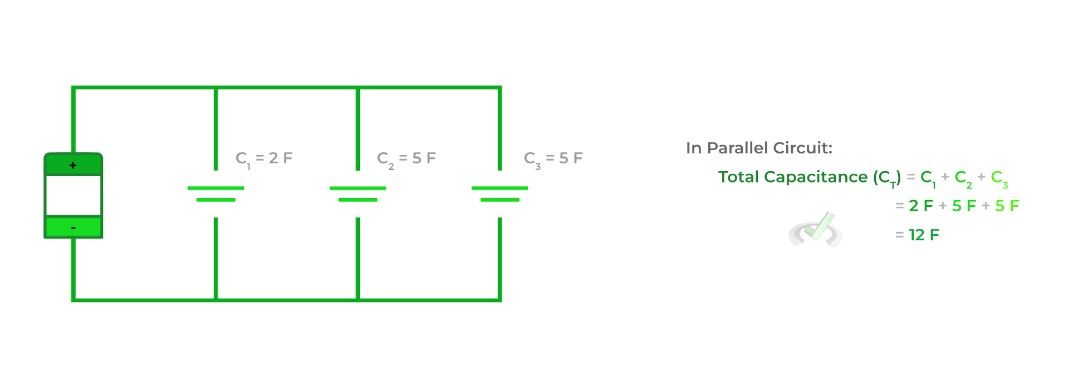
Full Study Notes : Capacitance and Capacitors
For more in-depth content review on capacitance and capacitors, check out these detailed lesson notes created by top MCAT scorers.
5. Types of Meters
When we want to measure a certain value within a circuit, such as the circuit’s current and voltage, we can attach different types of meters to the circuit to help determine these values!
There are 3 main types of meters: ammeters, voltmeters, and ohmmeters. The table below gives a great summary of what value each type of meter measures in a circuit.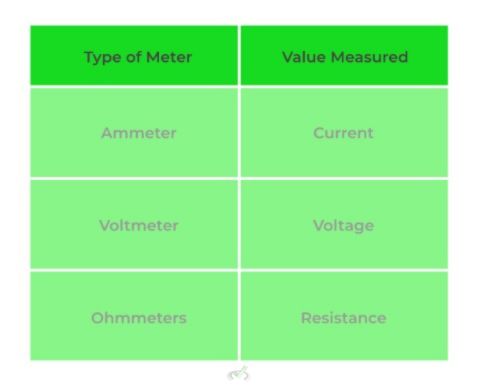
Full Study Notes : Types of Meters
For more in-depth content review on types of meter, check out these detailed lesson notes created by top MCAT scorers.
Important Definitions and Key Terms
Below are some high yield definitions and key terms to refer to when reviewing concepts and ideas about circuits!
Term | Definition |
|---|---|
Current | The amount of charge flowing per unit time; given in the SI units amps |
Conductance | Term used to describe how well a material can support an electric current; Mathematically, it’s the reciprocal of resistance |
Voltage | Described as the electric potential difference between 2 points; Can also be described as how much work in joules a charge generates |
Ohm's Law | States the voltage is equal to the product of current and resistance |
Resistance | Term used to describe how well an object opposes the flow of charges |
Capacitors | Circuit elements that have the ability to hold and store charge |
Ammeters | Device that can be used to measure the current flowing with in a circuit |
Voltmeters | Device used to measure the voltage (electric potential difference) between 2 points |
Ohmmeters | Device that can be used to measure resistance |
Additional FAQs - Circuits on the MCAT
Are Circuits on the MCAT?
What are Circuits in Physics? – MCAT?
However, in both cases, there are oxidation-reduction reactions that occur which result in the release of electrons which can flow through the circuit.
What is the Electromotive Force – MCAT?
What is a Circuit in Chemistry? – MCAT?
Additional Reading Links – Study Notes for Circuits on the MCAT
Additional Reading: Physics Topics on the MCAT:
- Atomic and Nuclear Phenomena on the MCAT
- Electrostatics on the MCAT
- Fluids on the MCAT
- Kinematics on the MCAT
- Light and Optics on the MCAT
- Magnetism on the MCAT
- Thermodynamics on the MCAT
- Units and Dimensional Analysis on the MCAT
- Waves and Sound on the MCAT
- Work and Energy on the MCAT







 To help you achieve your goal MCAT score, we take turns hosting these
To help you achieve your goal MCAT score, we take turns hosting these 





















 reviews on TrustPilot
reviews on TrustPilot